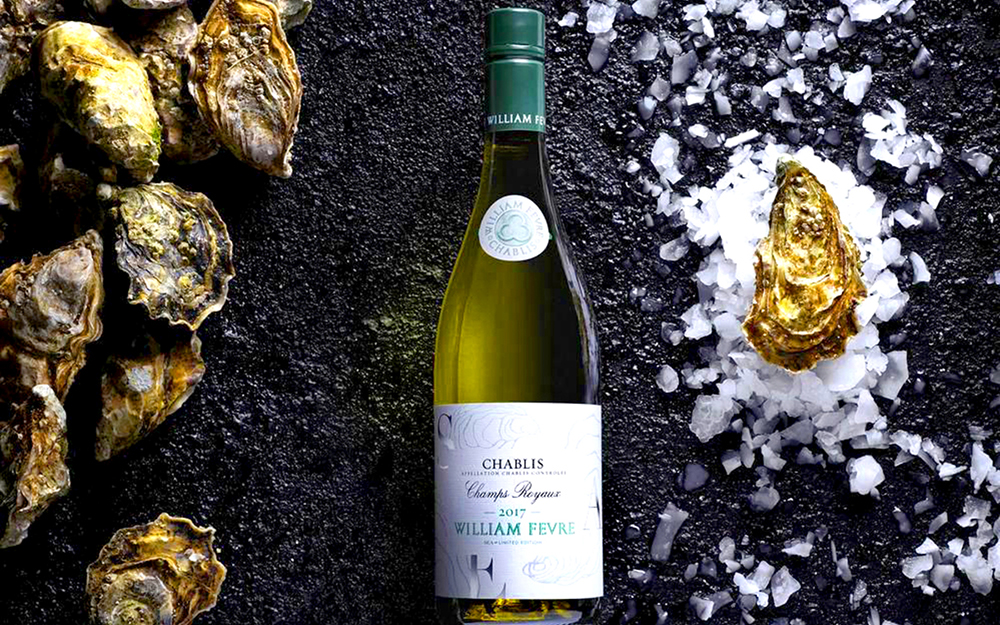
By Rick Riozza
All right! Let’s get right to the point. Slurping fresh oysters on the half shell alongside a good bottle of Chablis is one of life’s quintessential culinary pleasures.
For those of us who love the ocean, when one eats a fresh raw oyster, you are instantly transported to the seaside shore: you can smell the beach, imagine the breeze, and almost hear the waves crashing on the sand or the rocks.
When moving out here to the desert around ten years ago, I thought I would really miss living close to the ocean in Orange County. I really haven’t missed it that much (surely not the traffic), but after living there most of my life previously, I still love the seaside. Enjoying raw oysters brings to the senses the semblance of the sea.
So, while we’re on the subject, what wine comes to mind when oysters on the half shell are right in front of you? Actually, four wines come to my vino mentality that include Brut Champagne, Sauvignon Blanc, Muscadet, and the wine that appears in this article’s title—Chablis.
Brut Champagne pretty much goes with everything and anything, oysters included. Sauvignon Blanc is crisp and cleansing and will work as well. Muscadet, Sauv Blanc’s neighbor on the Loire River, is produced around Nantes off the Atlantic, and surely goes well with all fish and seafood—very clean and refreshing with subtle citrus flavors.
But—we’re on to pairing oysters with Chablis for this piece, so Chablis is indeed the star of the show. And, Chablis is the wine for all seasons & reasons and matches well with every kind of oyster on the planet. You name it, from the Pacific to the Atlantic, and that includes the desired Kumamoto, which is the tiny cousin of the Pacific oyster and the most Chablis friendly, where the wine brings out the pickled melon note in the oyster
As your friendly neighborhood wine steward, when I’m asked to suggest a white wine that goes with fresh oysters, of course I will offer up a nice bottle of Chablis. Often after a quick discussion, a lot of the times, the customer will speak of the wine as its own varietal. In other words, they’re not aware that it is a Chardonnay. And when they come to that realization, Chardonnay “haters” will dismiss that recommendation immediately! And that’s when the fun starts.
Well—Chablis is strictly Chardonnay country. And although geographically closer to Champagne than it is to the city of Dijon in Burgundy, Chablis is still considered “White Burgundy” which means Chardonnay wine.
As opposed to the very oaky, overly buttery Chardonnay—which still has many fans, as the pendulum moves, again there is an interest and a fast following for steely, fruit driven un-oaked Chardonnay. Let’s face it—it’s very refreshing and a very desirable quaff in our desert times, both summer and winter. California un-oaked Chardonnay is on the steely side of things—French Chablis Chardonnay is absolutely steely
We’ve called the Chablis Chard as the “Chardonnay that came in out of the cold.” The extremely cool-climate vineyards of Chablis need exceptional conditions to succeed. And here’s where the point of oyster pairing comes into the picture The Chardonnay grape converts the cold terroir of limestone chalk, clay, and trillions of oyster fossils to a wine with sharp flavors unique to the area—even its white burgundy sisters, in the form of Blanc de Blanc Champagne further south, can’t duplicate.
So it’s very enlightening for California Chardonnay lovers who like their stuff less oaky and more fresh fruit forward to wake up to the joys of French Chablis. The classic and delicious flavor profile of Chablis includes bright and dry textbook aromas and flavors of lemon, apple, yellow & green plums, stone fruit, melon, floral, citrus, seashore & sea breeze, flint & minerals.
Predominantly fermented in stainless steel—which keeps the wine astoundingly fresh and bright—“Grand Cru” and “Premiers Cru” wines, made from the best of the best vineyards in Chablis, can often ferment for a time in French oak which provides some complexities of honey, vanilla, light butterscotch, and tropical fruit flavors (with never an overwhelming “oak” flavor like some heavy Cal Chards). And, incredibly, these wines are able to age for ten to twenty years, gathering amazing feel and intensity that make it one of the world’s most desired wines.
An absolutely great Chablis recommendation is the recent release 2018 William Fevre’s Champs Royaux Chablis, at around $25. The winemaker’s notes are right on point: It is impressively precise, delivering a nose of citrus fruits, flowers, green apple and flinty flavors of wet stone in the mid-palate with a beautifully clean finish. Fresh, supple, it is marked by mineral notes, typical of the appellation.
For those of you who love Sauvignon Blanc with its clean and zesty flavors, you’ll find this wine to be an eye-opener when it comes to expanding your vino interests to other top quality, world famous wines.
And back to the oysters on a half shell, we remember that old advice that one should only eat oysters in the eight months of the year that contain the letter “R” in the name, which means September through April—that May through August are “bad” months for the half shell.
Well—sustainable oyster farming is good, clean, and viable all through the year. And realize that those slimy guys are alive until you take them down the hatch. It’s actually a really good thing because when those raw oysters die, they are no longer safe to eat.
Sounds like a good half dozen of Kumamoto coming up! Cheers!










































